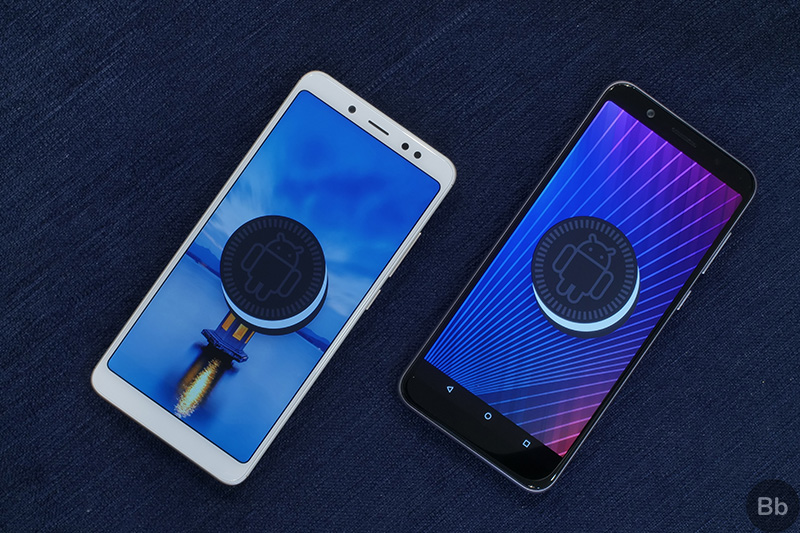While the original ZenFone Max Pro M1, which was released back in April this year, couldn’t beat Xiaomi’s Redmi Note 5 Pro to take the budget king crown, the updated version with 6GB RAM and better cameras on both the front and back stands a real shot at becoming the best budget smartphone in the country today. In order to find out how the two smartphones stack against each other, we put them to the test and compared them according to the following parameters. Let’s jump right into the comparison and see which smartphone emerges as the victor.
ZenFone Max Pro 6GB vs Redmi Note 5 Pro: Specs
First and foremost, let’s get the specifications of the competing devices out of the way. Both the devices are very similar when it comes to the specifications, packing a Snapdragon 636 SoC, 6GB of RAM and a 5.99-inch Full HD+ IPS LCD display. Here’s a quick look at the complete specifications of the two devices:
| ZenFone Max Pro M1 (6GB) | Redmi Note 5 Pro | |
| Dimensions and Weight | 159x76x8.5mm, 180gm | 158.6x75.4x8.1mm, 181gm |
| Display | 5.99-inch FHD+ IPS LCD (2160x1080 pixels) | 5.99-inch FHD+ IPS LCD (2160x1080 pixels) |
| Processor | Qualcomm Snapdragon 636 @1.8GHz | Qualcomm Snapdragon 636 @1.8GHz |
| GPU | Adreno 509 | Adreno 509 |
| RAM | 6GB | 6GB |
| Storage | 64GB | 64GB |
| Primary Camera | 16MP f/2.0 + 5MP f/2.4 | 12MP f/2.2 + 5MP f/2.0 |
| Secondary Camera | 16MP f/2.0 | 20MP f/2.2 |
| Battery | 5,000mAh | 4,000mAh |
| Operating System | Android 8.1 Oreo | MIUI 9.5 based on Android 8.1 Oreo |
| Price | Rs. 14,999 | Rs. 16,999 |
Design and Build Quality
Now that we’ve got the specifications out of the way, let’s focus on the design and build quality of the two devices. Design-wise, both the device share a very similar approach, featuring an 18:9 display up front with minimal bezels on the top and bottom, a vertically oriented dual camera setup on the back and a circular fingerprint sensor placed bang in the middle. Both the devices have the power and volume rocker on the right edge, the SIM tray on the left edge and the secondary microphone on the top edge. However, the Redmi Note 5 Pro also features an IR blaster on the top edge, which the ZenFone Max Pro lacks. On the bottom edge, the devices have the primary microphone, the headphone jack, the bottom firing speaker and a micro-USB port for charging and data syncing.

As you can see, design wise both the devices are pretty much identical, but even then the Redmi Note 5 Pro feels a little bit more premium and comfortable to hold that the ZenFone Max Pro M1. The device is slightly thinner than the ZenFone Max Pro M1, 0.4mm to be exact, and somehow that makes a whole lot of difference while handling the device, even though the Redmi Note 5 Pro is a gram heavier than the ZenFone Max Pro M1. On top of that, the Redmi Note 5 Pro feels a bit more premium than the ZenFone Max Pro M1, which is why it beats the latter when it comes to design and build quality.
Result: Redmi Note 5 Pro Wins
Display
Coming to the part of the devices which you’ll interact with the most – the display. As we mentioned previously, both the devices feature a 5.99-inch FHD+ IPS LCD display with a resolution of 2160×1080 pixels. Individually, both the displays look pretty great, they get fairly bright, color reproduction is quite accurate and the viewing angles are decent, however, when compared side-by-side, the Redmi Note 5 Pro’s display is just a tiny bit better.

The display on the Redmi Note 5 Pro gets a little bit brighter than the one on the ZenFone Max Pro M1, which improves the device’s outdoor visibility in direct sunlight. Another thing worth noting that the colors on the Redmi Note 5 Pro display are just a bit more vibrant than the ones on the ZenFone Max Pro M1. That doesn’t mean that the ZenFone Max Pro M1 has a bad display, it’s pretty decent to be honest, but the Redmi Note 5 Pro’s display is still a bit better.
Result: Redmi Note 5 Pro Wins
Performance
Since both the devices come with pretty much the same hardware, you’d expect them to perform equally well and that’s the case for the most part. Both the devices are capable of running most games at medium to low graphical settings and they do so without the slightest stutter or frame drop. Benchmark results are also pretty comparable, but the ZenFone Max Pro M1 posts slightly higher scores in AnTuTu, while the Geekbench 4 scores are just a couple of points apart.

Gaming performance on both the devices is also pretty great, with both the devices managing to run games like PUBG Mobile, Asphalt 9, Shadowgun Legends and Tekken without a hitch. However, due to the fact that the ZenFone Max Pro M1 is running near stock Android, it’s able to hold more applications open in memory which greatly improves the multi-tasking performance. Here, the Redmi Note 5 Pro’s heavy MIUI skin gives it a bit of a handicap, but the difference isn’t that significant. In my opinion, both the devices perform equally well, but the near stock Android ROM on the ZenFone Max Pro M1 gives it a slight edge over the Redmi Note 5 Pro.
Result: ZenFone Max Pro M1 Wins
Software
As I just mentioned, the ZenFone Max Pro M1 runs near stock Android 8.1 Oreo while the Redmi Note 5 Pro runs MIUI 9.5 based on Android 8.1 Oreo. Both the devices offer a fair bit of customizations, but the MIUI 9.5 running on the Redmi Note 5 Pro includes an absolute ton of useful features that gives it a slight edge over the ZenFone Max Pro M1. But, as you’d already know, we at Beebom value the stock Android experience far more than any custom skin and therefore prefer the ZenFone Max Pro M1’s UI.

In case you’re an MIUI fan, you’d obviously prefer the Redmi Note 5 Pro, but do note that the heavily skinned UI has a significant effect on the device’s performance as it reserves some of the RAM to run the customizations. Another area where the stock Android experience trumps MIUI is updates. Since the ZenFone Max Pro M1 runs stock Android, Asus will be able to push new updates faster than Xiaomi, which is anyway known for its poor update cycles. With that in mind, it’s safe to say that the ZenFone Max Pro M1 fares better than the Redmi Note 5 Pro in the software department.
Result: ZenFone Max Pro M1 Wins
Cameras
On paper, the ZenFone Max Pro M1 has a better rear camera setup than the Redmi Note 5 Pro. The ZenFone sports a 16MP+5MP dual camera setup on the back, while the Note 5 Pro just hass a 12MP+5MP dual camera setup. However, in real world use, the ZenFone Max Pro M1’s camera just doesn’t perform as well as the one on the Redmi Note 5 Pro. Just take a look at the samples below:
Up front, the ZenFone Max Pro M1 has a 16MP shooter while the Redmi Note 5 Pro has a 20MP shooter, and as you’d expect, the Redmi Note 5 Pro delivers better selfies than the ZenFone Max Pro M1 in pretty much every scenario. Take a look at the samples below:
Both the devices also feature portrait mode, with the 5MP secondary sensors providing the depth effect. In this case as well, the Redmi Note 5 Pro outshines the ZenFone, delivering great portrait shots time and time again. Here are a few samples taken by both the devices:
It’s quite clear that the Redmi Note 5 Pro beats the ZenFone Max Pro M1 in the camera department. If you’re still not convinced, you can check out our extensive comparison of the cameras on both the devices.
Result: Redmi Note 5 Pro Wins
ZenFone Max Pro M1 vs. Redmi Note 5 Pro: Battery
The ZenFone packs in a massive 5,000mAh battery and it’s no surprise that it delivers better battery life than the Redmi Note 5 Pro which has a 4,000mAh battery. While the 4,000mAh battery on the Redmi Note 5 Pro isn’t bad by any means, it just isn’t as good as the one on the ZenFone Max Pro M1. Without a doubt, the ZenFone Max Pro M1 is the better device when it comes to battery performance.

When it comes to charging up the battery, however, the Redmi Note 5 Pro performs better than the ZenFone Max Pro M1, thanks to Quick Charge 2.0 support. But the included charging brick doesn’t support QC 2.0, so you’ll have to invest in a compatible charger to charge up your device fast. The ZenFone Max Pro M1 on the other hand doesn’t feature fast charge support and takes well over two and a half hours to go from 10 to 100 percent.
Result: ZenFone Max Pro M1 Wins
See Also: ZenFone Max Pro M1 6GB vs. Redmi Note 5 Pro Camera Showdown
ZenFone Max Pro 6GB vs Redmi Note 5 Pro: And The Winner Is?
As you can see, there isn’t a clear winner and you’ll have to get your priorities straight before you invest in either smartphone. While the ZenFone is better when it comes to performance, UI and battery life, the Redmi Note 5 Pro offers a better build quality, superior camera performance and a slightly better display. In case you’re looking for a budget smartphone that offers great performance, near stock Android and brilliant battery life, then the ZenFone Max Pro M1 is the one you should go for. However, if you’re looking for better cameras, display and build quality, then the Redmi Note 5 Pro is your best bet. I personally value a great camera over everything else and as such would pick the Redmi Note 5 Pro, but your priorities might be different. In conclusion, both devices have their own strong suits and you should pick one that best fits your use case.
Buy ZenFone Max Pro 6GB (Rs. 14,999)
Buy Redmi Note 5 Pro (starts at Rs. 14,999)



























